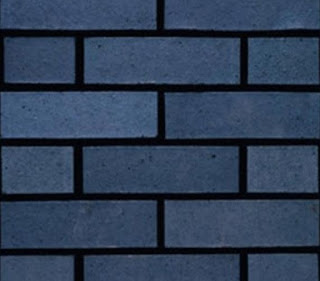Difference Between Blue Engineering Bricks and Black Limestone Slabs
Blue Engineering Bricks and Black Limestone Slabs are very different
materials. Blue Engineering Bricks are bricks that have been fired at ultra-high
temperatures in a very low oxygen environment. This process makes them very
strong, very hard, and gives them their distinctively smooth blue/black
appearance. They are a decidedly industrial product and are generally used in
foundations, meaning that they are not generally on display.
Our Kotah
Black limestone paving on the other hand is completely natural. Quarried
from the living rock and then simply cut to shape. Its dark colour, with shades
of grey and silver running through the surface is entirely natural, there are
no dyes, chemicals or industrial processes involved at any point in the
production of our black limestone paving.
However, while these two building products are very different, they do
have many features which complement each other. The dark colouring of blue
Engineering Bricks and our Black Limestone lends them a sleek, urban look which
can provide a wonderful contrast with the lush greens of garden shrubs and an
interesting alternative to the more traditional grey limestones that have been
the default for garden paving for so long.
The two materials are also extremely durable. This durability is
literally baked in to blue engineering bricks – they are designed for the
construction of building foundations and so have been created to have
incredible strength, especially when being compressed. No such engineering goes
into black limestone slabs, which are just naturally strong. Limestone is one
of the softer rocks – much less hard and dense than stones like granite, for
example – but it is still a rock. When you lay down patios or pathways using
black limestone slabs you can be sure that they will be able to take whatever
punishment the British weather choose to throw at them.
Black limestone and blue engineering bricks are also extremely easy to
maintain. In the case of engineering bricks, you are unlikely to have to
undertake any maintenance at all – their hard, smooth surface does not
generally suffer the weathering or algae growth that can sometimes mar the
appearance of regular clay bricks. Black limestone can sometimes be affected by
moss or algae, which left unchecked can be unsightly, but all you ever need to
do is give the affected area a brief blast from a pressure washer to bring it
back to pristine condition.
The durability which is inherent to both materials also make them
extremely reusable. When structures that have been constructed from blue
engineering bricks or black limestone are eventually removed, the building
materials can be salvaged, reclaimed and reused. This makes them incredibly
environmentally friendly materials because such reuse completely cuts out the
energy needed to make new bricks or cut more stone.
So yes, the two building materials are very different. One is a
manufactured industrial product, one is a natural product that has literally
been formed in the earth over millennia. But they work incredibly well together
to create practical, functional outdoor spaces that look great, are easy to
maintain and will last for decades. A clear case of opposites attracting, we
would say.




Comments
Post a Comment